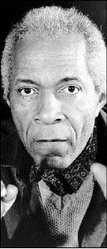
A scene from 'Smile Orange' at the Barn Theatre in 1971. Seen left to right are Stan Hons, Carl Bradshaw, Vaughn Crosskill, Grace McGhie and Hornell Pansei. - File
Is there anything left to say about Smile Orange? Who amongst us, almost four decades after its initial run, does not know its quintessentially Jamaican protagonist, the pragmatic and irrepressible trickster Ringo Smith? He long ago escaped the typed page, long ago bounced off the Barn Theatre stage into our collective consciousness, more real to us than Paul Bogle or Marcus Garvey, men who lived and died but have since faded into the obscure purgatory of history textbooks and primary school walls.
Who among us, almost three million souls surrounded by white sand and water, is ignorant of its truths? Smile Orange tells us about ourselves, as art should - about living in America's shadow; about using what you have to get what you want; about wanting what you can't have; about the white man and the black man and everything in between; and finally, about how Jamaica is, and must be, a place where these truths are self-evident.
And who among us is not indebted to its scribe, the incomparable Trevor Rhone? The man cobbled together a rural childhood, a foreign education and an intractable dissatisfaction with his circumstance into a string of stage plays stretching from The Gadget (1969) and Smile Orange (1971) to Old Story Time (1979) and Two Can Play (1982). Even that impressive list underrepresents his contribution to the ongoing experiment called Jamaica - for instance, co-writing The Harder They Come (1972) with the late Perry Henzell.
Smile Orange was Rhone's first hit, and deservedly so, running for 245 performances. Although the new production is at The Little Little Theatre, rather than the more historically resonant Barn, the magic lingers still. So much time has passed that the stage, dressed and waiting for actors, is by itself a kind of museum, a time capsule preserving the hopes, fears and laughs of a people who were barely 10 years into Independence - Miss Brandon's curved desk, the pastel orange and sea green walls, the cursive hotel insignia, the scuffed furniture in the waiters' area.
Past and present

'Smile Orange's' writer, Trevor Rhone. - File
And then the lights are up, Ringo bustles down the aisle, Joe changes his coat, Miss Brandon fixes her make-up and Smile Orange pulls you into its peculiar world, now simultaneously past and present. Ringo, once a young, lithe Carl Bradshaw, much later an energetic Glen Campbell, is now the wiry, madcap Donald Anderson, who slips comfortably into the iconic orange waistcoat and bow tie. Everaldo Creary is pitch-perfect as the bumbling, blubbering bus boy, Cyril - almost crippled with fear, his scenes with Anderson crackle and pop. Shaun Drysdale and Gracia Thompson, as Joe and Miss Brandon, are convincing, if not captivating. Hugh Douse, as the assistant manager, Mr O'Keefe, is less so.
Such a trifle cannot spoil the show, especially with Mr Rhone as director. With such talent, why this play, yet again? We still need cogent voices to skewer our lives in song and dance, onstage and screen. The world is different than it was 40 years ago when Mr Rhone and his friends turned a residence into a theatre, and thus a house into a home. Why not a new play, from hands informed by all that has gone before, by gadgets and games, schools and smiles, oranges and old stories?
If you haven't seen Smile Orange, go and see it. If you have seen it, go and remind yourself. In the warm afterglow of the production, when smiles come easily, if you see Trevor Rhone, tell him he still has the last laugh, inside, waiting to come out.
reviews@keiranking.com